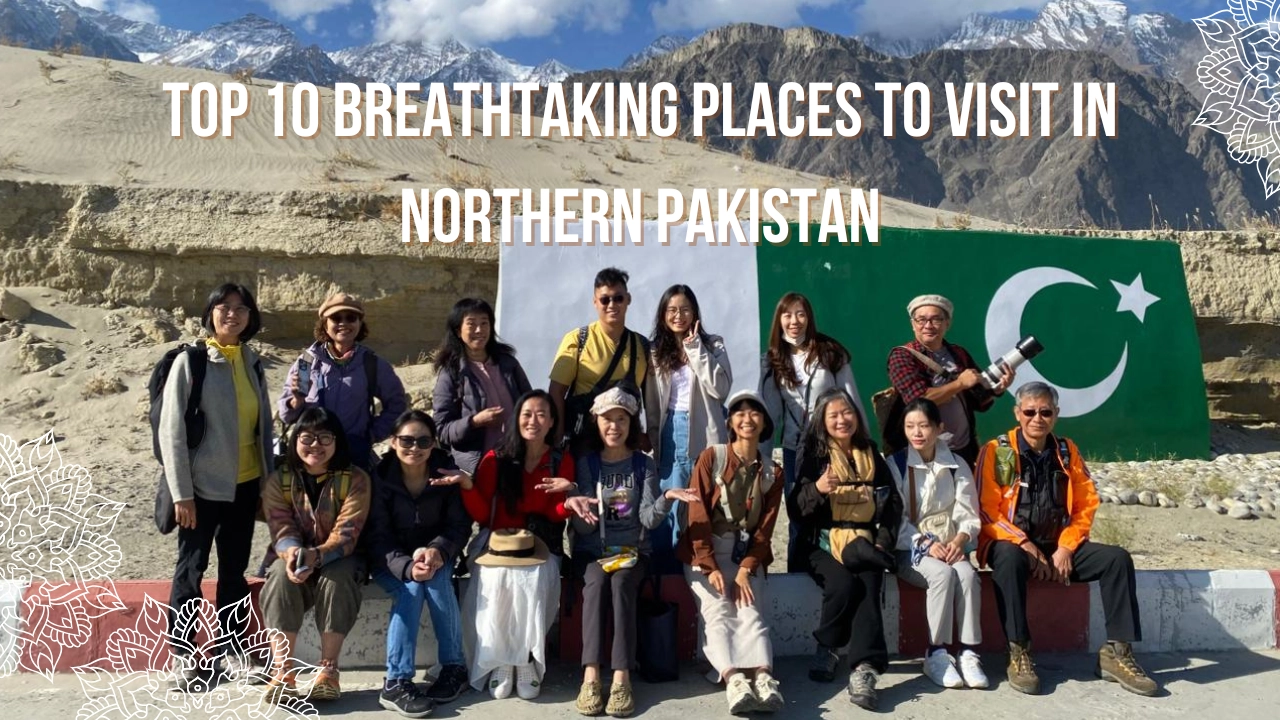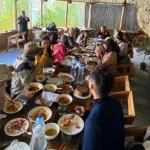If there’s one part of Pakistan that feels like it was sculpted by nature itself, it’s the North. Snow-capped peaks, turquoise lakes, lush valleys, and timeless villages Northern Pakistan is pure magic. Every turn of the road reveals a new wonder, every sunrise feels like a fresh chapter, and every destination has a story to tell.
Whether you’re an adventure lover, nature enthusiast, or just someone looking to escape the city rush, the northern region offers an unforgettable experience. In this guide, we’ll explore the top 10 breathtaking places to visit in Northern Pakistan, each offering something truly unique.
1. “Hunza Valley” The Crown Jewel of the North
No list of Northern Pakistan is complete without Hunza Valley. Often called “Heaven on Earth,” Hunza is known for its serene beauty, friendly locals, and rich culture. The valley is surrounded by towering mountains like Rakaposhi, Ultar Sar, and Ladyfinger Peak.
Wander through the peaceful streets of Karimabad, explore the historic Baltit and Altit Forts, or just sit by Attabad Lake and soak in its stunning blue waters. Hunza isn’t just a destination it’s an emotion that stays with you long after you’ve left.
Best time to visit: April to October
2. “Skardu” Gateway to the Mighty Karakoram
Skardu is where adventure meets tranquility. It’s the starting point for trekkers heading toward the world’s highest peaks, including K2, the second-highest mountain on Earth. But Skardu’s beauty goes beyond its peaks.
Visit Shangrila Lake (Lower Kachura), Upper Kachura Lake, and the mesmerizing Deosai National Park, known as the “Land of Giants.” The blend of crystal-clear lakes, rugged landscapes, and starry skies makes Skardu an unforgettable stop in Northern Pakistan.
If you’re planning a well-organized trip here, Harappa Tour & Travel offers guided packages that help you experience Skardu’s magic without missing a single landmark.
Best time to visit: May to September
3. “Fairy Meadows” A Window to Nanga Parbat
Imagine waking up to the view of the 9th highest mountain in the world, Nanga Parbat, bathed in golden morning light. That’s Fairy Meadows for you a true slice of paradise.
The meadows are a lush green expanse at the base of the mountain, accessible after a thrilling jeep ride and a short trek. It’s a favorite spot for trekkers and photographers who want to experience Pakistan’s raw natural beauty.
At night, the view of Nanga Parbat under a star-filled sky feels nothing short of magical.
Best time to visit: June to August
4. “Naltar Valley” The Land of Enchanting Lakes
Hidden deep in the Gilgit-Baltistan region, Naltar Valley is famous for its colorful lakes and dense pine forests. The Naltar Lakes, often called the “Bashkiri Lakes,” change colors with the light from emerald green to sapphire blue.
Naltar is also home to Pakistan’s first ski resort, making it an ideal destination for winter lovers. Unlike other crowded tourist spots, Naltar offers peace and isolation for those seeking a quiet retreat surrounded by untouched nature.
Best time to visit: May to October

5. “Hooper Valley” The Glacier Paradise of Hunza
Located near Nagar in the Hunza region, Hooper Valley (often spelled Hopper Valley) is a breathtaking spot known for its majestic glaciers, lush green pastures, and peaceful village life. The valley offers unmatched views of Spantik Peak, also known as the “Golden Peak,” and the Hooper Glacier, which stretches down from the mighty Karakoram Range.
Visitors often hike through the valley’s winding trails, passing fruit orchards and traditional stone houses that reflect the warm hospitality of the locals. During summer, the fields bloom with wildflowers, while autumn paints the valley in gold and red hues.
If you’re seeking an off-the-beaten-path destination with a mix of adventure and serenity, Hooper Valley is a must-visit. It’s a photographer’s dream and a nature lover’s escape.
Best time to visit: May to October
6. “Kalash Valley” The Living Heritage of Chitral
Nestled deep in the Chitral region, Kalash Valley is a land of vibrant colors, ancient traditions, and unmatched natural beauty. It is home to the Kalash people, one of the most unique ethnic groups in the world, known for their distinct culture, colorful clothing, and joyful festivals.
The three main valleys “Bumburet, Rumbur, and Birir” are surrounded by lush green hills and flowing rivers. During the Chilam Joshi Festival in spring and Uchal Festival in summer, the entire valley bursts into celebration with dance, music, and cultural performances.
Kalash Valley isn’t just a place to visit it’s an opportunity to witness a way of life preserved for centuries, tucked away in Pakistan’s northern mountains.
Best time to visit: May to September
7. “Khunjerab Pass” Where Pakistan Meets China
Perched at over 15,000 feet above sea level, Khunjerab Pass is the highest paved international border crossing in the world. It connects Pakistan with China through the legendary Karakoram Highway, often called the “Eighth Wonder of the World.”
The view here is surreal vast mountain ranges covered in snow and a feeling that you’re standing at the top of the world. You might even spot a snow leopard if you’re lucky!
Harappa Tour & Travel often includes Khunjerab Pass in its customized Northern adventure routes, giving travelers a smooth and scenic experience.
Best time to visit: May to October
8. “Naran Kaghan” The Heart of Northern Adventure
Located in the Mansehra District of Khyber Pakhtunkhwa, Naran Kaghan one of Pakistan’s most popular travel destinations and for good reason. With lush meadows, snow-clad mountains, and crystal-clear rivers, it’s a paradise for nature lovers and adventure seekers alike.
Explore Lake Saif-ul-Malook, a magical alpine lake surrounded by towering peaks and folklore that adds to its mystery. Take a jeep ride to Lulusar Lake and Babusar Top, where panoramic views of the Himalayas will take your breath away.
The pleasant weather, combined with the warm hospitality of locals, makes Naran Kaghan the perfect summer retreat for families, couples, and travel groups.
Best time to visit: May to September
9. “Rama Lake” A Serene Gem of Astore
Astore District’s Rama Lake is a hidden gem that feels like a dream come true. The lake sits at an altitude of 3,300 meters, surrounded by snow-covered mountains and lush pine forests.
It’s one of those places where time seems to slow down perfect for reflection, photography, and simply breathing in nature. The nearby Rama Meadows offer breathtaking views of Nanga Parbat, completing this perfect northern experience.
Best time to visit: June to September
10. “Passu Cones” Nature’s Architectural Marvel
Located along the Karakoram Highway in Hunza, the Passu Cones (or Cathedral Peaks) are among the most photographed mountains in Pakistan. Their sharp, pyramid-like structure rises dramatically from the valley, creating a view that feels almost unreal.
You can stop by the Passu Glacier or the Hussaini Suspension Bridge, known as one of the most thrilling bridges in the world. The combination of adventure, serenity, and awe-inspiring views makes Passu a must-see destination.
Best time to visit: April to October
Travel Tips for Exploring Northern Pakistan
- Plan ahead: Some areas require special permits or early hotel bookings during peak season.
- Pack smart: Weather can change quickly, so bring warm layers even in summer.
- Respect local culture: Northern communities are deeply rooted in tradition always be courteous and humble.
- Go local: Support small guesthouses, local guides, and artisans whenever possible.
A Journey You’ll Remember Forever
Northern Pakistan isn’t just a place it’s an experience that stirs the soul. From the calm waters of Hunza to the wild peaks of Skardu, every destination tells a story of beauty, resilience, and wonder.
If you’re ready to turn your travel dreams into reality, Harappa Tour & Travel can help you plan your perfect northern adventure safely, comfortably, and with a touch of local expertise.
So pack your bags, charge your camera, and prepare for one of the most breathtaking journeys of your life. Because once you visit Northern Pakistan, your heart will always find its way back.



